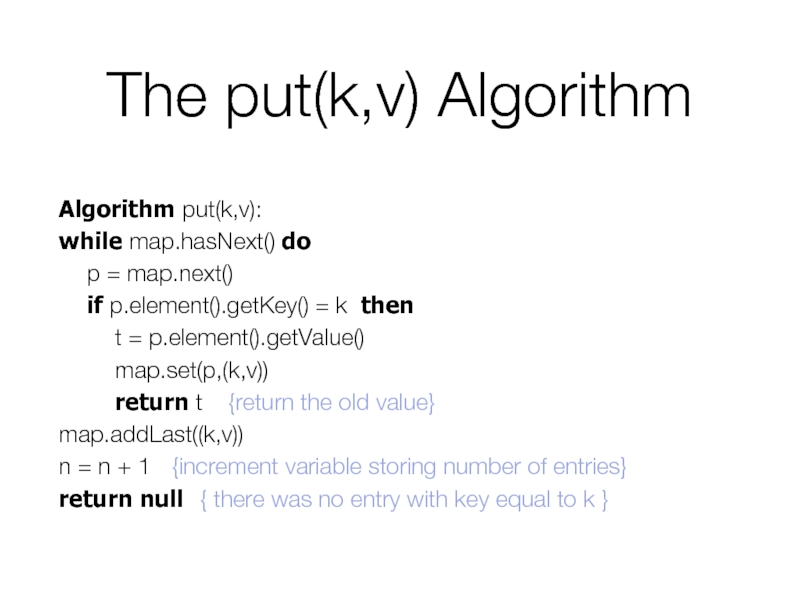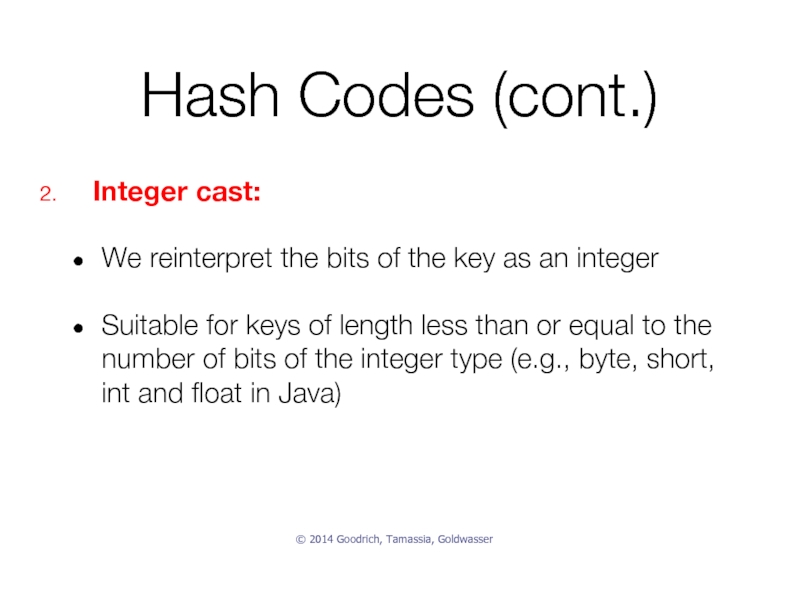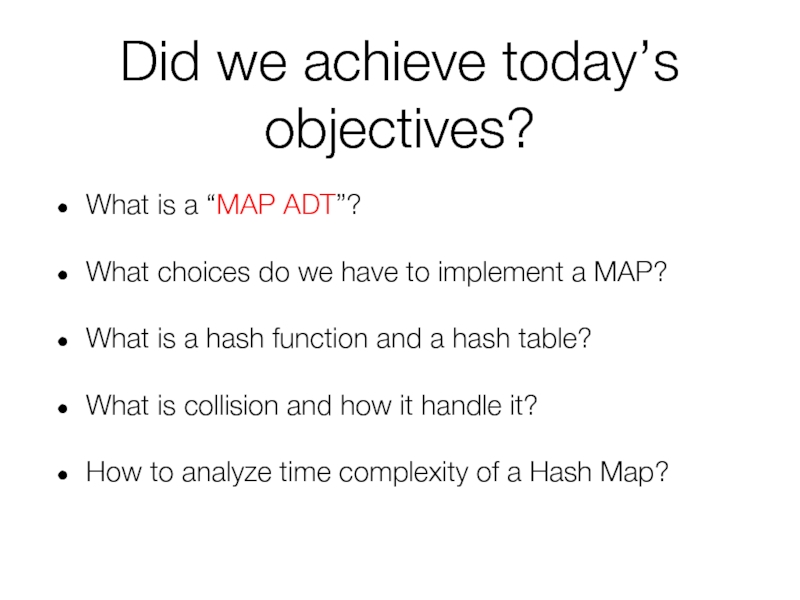- Главная
- Разное
- Дизайн
- Бизнес и предпринимательство
- Аналитика
- Образование
- Развлечения
- Красота и здоровье
- Финансы
- Государство
- Путешествия
- Спорт
- Недвижимость
- Армия
- Графика
- Культурология
- Еда и кулинария
- Лингвистика
- Английский язык
- Астрономия
- Алгебра
- Биология
- География
- Детские презентации
- Информатика
- История
- Литература
- Маркетинг
- Математика
- Медицина
- Менеджмент
- Музыка
- МХК
- Немецкий язык
- ОБЖ
- Обществознание
- Окружающий мир
- Педагогика
- Русский язык
- Технология
- Физика
- Философия
- Химия
- Шаблоны, картинки для презентаций
- Экология
- Экономика
- Юриспруденция
Data Structures and Algorithms презентация
Содержание
- 1. Data Structures and Algorithms
- 2. Recap Elementary data structures ADT Array based
- 3. Today’s Objectives What is a “MAP or
- 4. Map or Dictionary
- 5. Map or Dictionary Models a searchable dynamic
- 6. The Map ADT get(k): if the map
- 7. Example Operation Output Map isEmpty() true Ø put(5,A) null (5,A) put(7,B) null (5,A),(7,B) put(2,C) null (5,A),(7,B),(2,C) put(8,D) null (5,A),(7,B),(2,C),(8,D)
- 8. A Simple List-Based Map We can implement
- 9. The get(k) Algorithm Algorithm get(k): while map.hasNext()
- 10. The put(k,v) Algorithm Algorithm put(k,v): while map.hasNext()
- 11. The remove(k) Algorithm Algorithm remove(k): while map.hasNext()
- 12. Performance of a List-Based Map Performance: put
- 13. Hash Map
- 14. Let’s Start With this Question How much
- 15. Example Suppose you’re writing a program to
- 16. Example (cont.) The easiest way to do
- 17. Example (cont.) The speed and simplicity of
- 18. Example (cont.) But mostly, the keys are
- 19. What Did We Learn From The Example?
- 20. Hash Map Hash Table is a very practical way to maintain a map
- 21. Hash Table
- 22. Hash Table
- 23. Hash Function A hash function h maps
- 24. Simple Hash Function for Integers
- 25. General Hash Functions A hash function is
- 26. Parts of a Hash Function © 2014 Goodrich, Tamassia, Goldwasser
- 27. Ideal Hash Function Every resulting hash value
- 28. Some Principles If n items are placed
- 29. Collisions So collisions are inevitable Our goal
- 30. Tip! Designing a hash function is a
- 31. Hash Codes Memory address: We reinterpret the
- 32. Hash Codes (cont.) Integer cast: We reinterpret
- 33. Hash Codes (cont.) Component sum: We partition
- 34. Hash Codes (cont.) We partition the
- 35. Compression Functions Division: h2 (y) = y
- 36. Compression Functions Multiply, Add and Divide (MAD)
- 37. Collision Handling
- 38. Collision Handling Separate Chaining: let each cell
- 39. Analysis of get(k) in Separate Chaining
- 40. Analysis of get(k) in Separate Chaining
- 41. Collision Handling Open Addressing: the colliding item
- 42. Example Example: Linear probing h(x) = x
- 43. Example Example: Linear probing h(x) = x
- 44. Search with Linear Probing Consider a hash
- 45. Updates with Linear Probing To handle insertions
- 46. Updates with Linear Probing put(k, o) We
- 47. Collision Handling Open Addressing: the colliding item
- 48. Double Hashing The secondary hash function cannot
- 49. Double Hashing Common choice of compression function
- 50. Example Consider a hash table storing integer
- 51. Example Consider a hash table storing integer
- 52. Analysis of get(k) in Open Addressing
- 53. Did we achieve today’s objectives? What is
Слайд 1Data Structures & Algorithms
Adil M. Khan
Professor of Computer Science
Innopolis University
Lecture 4
Слайд 2Recap
Elementary data structures
ADT
Array based vs. linked implementation
Worst case time complexity to
Слайд 3Today’s Objectives
What is a “MAP or Dictionary ADT”?
What choices do we
What is a hash function and a hash table?
What is collision and how to handle it?
How to analyze time complexity of a Hash Map?
Слайд 5Map or Dictionary
Models a searchable dynamic set of key-value entries
Main operations
Applications:
Compiler symbol table
A news indexing service
Слайд 6The Map ADT
get(k): if the map M has an entry with
put(k, v): insert entry (k, v) into the map M; if key k is not already in M, then return null; else, return old value associated with k
remove(k): if the map M has an entry with key k, remove it from M and return its associated value; else, return null
size(), isEmpty()
entrySet(): return an iterable collection of the entries in M
keySet(): return an iterable collection of the keys in M
values(): return an iterator of the values in M
Слайд 7Example
Operation Output Map
isEmpty() true Ø
put(5,A) null (5,A)
put(7,B) null (5,A),(7,B)
put(2,C) null (5,A),(7,B),(2,C)
put(8,D) null (5,A),(7,B),(2,C),(8,D)
put(2,E) C (5,A),(7,B),(2,E),(8,D)
get(7) B (5,A),(7,B),(2,E),(8,D)
get(4) null (5,A),(7,B),(2,E),(8,D)
get(2) E (5,A),(7,B),(2,E),(8,D)
size() 4 (5,A),(7,B),(2,E),(8,D)
remove(5) A (7,B),(2,E),(8,D)
remove(2) E (7,B),(8,D)
get(2) null (7,B),(8,D)
isEmpty() false (7,B),(8,D)
© 2014 Goodrich, Tamassia, Goldwasser
Слайд 8A Simple List-Based Map
We can implement a map using an unsorted
We store the items of the map in a list S (based on a doublylinked list), in arbitrary order
© 2014 Goodrich, Tamassia, Goldwasser
Слайд 9The get(k) Algorithm
Algorithm get(k):
while map.hasNext() do
p = map.next() { the next
if p.element().getKey() = k then
return p.element().getValue()
return null {there is no entry with key equal to k}
Слайд 10The put(k,v) Algorithm
Algorithm put(k,v):
while map.hasNext() do
p = map.next()
if p.element().getKey() = k
t = p.element().getValue()
map.set(p,(k,v))
return t {return the old value}
map.addLast((k,v))
n = n + 1 {increment variable storing number of entries}
return null { there was no entry with key equal to k }
Слайд 11The remove(k) Algorithm
Algorithm remove(k):
while map.hasNext() do
p = map.next()
if p.element().getKey() = k
t = p.element().getValue()
map.remove(p)
n = n – 1 {decrement number of entries}
return t {return the removed value}
return null {there is no entry with key equal to k}
Слайд 12Performance of a List-Based Map
Performance:
put takes O(1) time since we can
get and remove take O(n) time since in the worst case (the item is not found) we traverse the entire sequence to look for an item with the given key
The unsorted list implementation is effective only for maps of small size or for maps in which puts are the most common operations, while searches and removals are rarely performed (e.g., historical record of logins to a workstation)
Слайд 14Let’s Start With this Question
How much time does it take to
Слайд 15Example
Suppose you’re writing a program to access employee records for a
Goal: fastest possible access to any individual record
Each employee has a number from 1(founder) to 1000 (the most recent worker)
Employees are seldom laid off, and even when they are, their record stays in the database.
Слайд 16Example (cont.)
The easiest way to do this is by using an
Each employee record occupies one cell of the array
The index number of the cell is the employee number
empRecord rec = databaseArray[72];
databaseArray[totalEmployees++] = newRecord;
Слайд 17Example (cont.)
The speed and simplicity of data access using this array-based
However, it works in our example only because keys are well organized
Sequentially from 1 to a known maximum
No deletions required
New items can be added sequentially at the end
Слайд 18Example (cont.)
But mostly, the keys are not so well behaved
A simple
Array indexing requires integer
One more problem: Even when using integers, the value could be outside of the range of the array
Слайд 19What Did We Learn From The Example?
Arrays are very fast when
But “key” → “index” mapping only works when
keys are integers, and
are within the bound, and
are not changed
Слайд 23Hash Function
A hash function h maps keys of a given type
Example: h(x) = x mod N is a hash function for integer keys
The integer h(x) is called the hash value of key x
Слайд 25General Hash Functions
A hash function is usually specified as the composition
Hash code: h1: keys → integers
Compression function: h2: integers → [0, N → 1]
The hash code is applied first, and the compression function is applied next on the result, i.e.,
h(x) = h2(h1(x))
The goal of the hash function is to “disperse” the keys in a uniform manner
Слайд 27Ideal Hash Function
Every resulting hash value has exactly one input that
Same key hashes to the same index (repeatable)
Hash value is widely different if even a single bit is different in the key (avalanche)
Should work in general (for different types)
Слайд 28Some Principles
If n items are placed in m buckets, and n
This is called collision (two keys hash to the same index)
Birthday paradox
https://en.wikipedia.org/wiki/Birthday_problem
Слайд 29Collisions
So collisions are inevitable
Our goal should therefore be to minimize collisions
We
Generating better hash codes
Performing better compression
Handling collisions
Слайд 30Tip!
Designing a hash function is a black art
It is always better
But sometimes, as a student, it is better to try to design one for the sake of practice
Слайд 31Hash Codes
Memory address:
We reinterpret the memory address of the key object
Good in general, except that it is not repeatable
© 2014 Goodrich, Tamassia, Goldwasser
Слайд 32Hash Codes (cont.)
Integer cast:
We reinterpret the bits of the key as
Suitable for keys of length less than or equal to the number of bits of the integer type (e.g., byte, short, int and float in Java)
© 2014 Goodrich, Tamassia, Goldwasser
Слайд 33Hash Codes (cont.)
Component sum:
We partition the bits of the key into
Fails to treat permutations differently (“abc”, “cba”, “cab”)
© 2014 Goodrich, Tamassia, Goldwasser
Слайд 34Hash Codes (cont.)
We partition the bits of the key into a
a0 a1 … an−1
We evaluate the polynomial
p(z) = a0 + a1 z + a2 z2 + … … + an−1zn−1
at a fixed value z
Especially suitable for strings (e.g., the choice z = 33 gives at most 6 collisions on a set of 50,000 English words)
© 2014 Goodrich, Tamassia, Goldwasser
Polynomial accumulation:
Слайд 35Compression Functions
Division:
h2 (y) = y mod N
The size N of the
Helps “spread out” the distribution of hashed values
Try inset keys with hash codes {200, 205, 210, 215, …, 600} into a table size of 100 vs. 101
Слайд 36Compression Functions
Multiply, Add and Divide (MAD)
h2 (y) = [(ay + b)
p is a prime number larger than N
a and b are integers from the interval [0, p – 1], with a > 0
Слайд 38Collision Handling
Separate Chaining: let each cell in the table point to
Separate chaining is simple, but requires additional memory outside the table
Слайд 41Collision Handling
Open Addressing: the colliding item is placed in a different
Linear Probing: handles collision by placing the item in the next (circularly) available cell
Each cell inspected is called a probe
Colliding items lump together, causing future collisions to cause a longer sequence of probes
Слайд 42Example
Example:
Linear probing
h(x) = x mod 13
Insert keys 18, 41, 22, 44,
Слайд 43Example
Example:
Linear probing
h(x) = x mod 13
Insert keys 18, 41, 22, 44,
Слайд 44Search with Linear Probing
Consider a hash table A that uses linear
get(k)
We start at cell h(k)
We probe consecutive locations until one of the following occurs
An item with key k is found, or
An empty cell is found, or
N cells have been unsuccessfully probed
Algorithm get(k)
i ← h(k)
p ← 0
repeat
c ← A[i]
if c = ∅
return null
else if c.getKey () = k
return c.getValue()
else
i ← (i + 1) mod N
p ← p + 1
until p = N
return null
Слайд 45Updates with Linear Probing
To handle insertions and deletions, we introduce a
remove(k)
We search for an entry with key k
If such an entry (k, o) is found, we replace it with the special item DEFUNCT and we return element o
Else, we return null
Слайд 46Updates with Linear Probing
put(k, o)
We throw an exception if the table
We start at cell h(k)
We probe consecutive cells until the following occurs
A cell i is found that is either empty or stores DEFUNCT, or
We store (k, o) in cell i
Слайд 47Collision Handling
Open Addressing: the colliding item is placed in a different
B. Double Hashing: uses a secondary hash function d(k) and handles collision by placing an items in the first available of cell of the series
(h(k) + jd(k)) mod N
for j = 1, … , N − 1
Слайд 48Double Hashing
The secondary hash function cannot have zero values
The table size
Слайд 49Double Hashing
Common choice of compression function for the secondary hash function:
d(k) = q − (k mod q)
where
q • N
q is a prime
The possible values for d(k) are
1, 2, … , q
Слайд 50Example
Consider a hash table storing integer keys that handles collision with
N = 13
h(k) = k mod 13
d(k) = 7 − k mod 7
Insert keys 18, 41, 22, 44, 59, 32, 31, 73, in this order
Слайд 51Example
Consider a hash table storing integer keys that handles collision with
N = 13
h(k) = k mod 13
d(k) = 7 − k mod 7
Insert keys 18, 41, 22, 44, 59, 32, 31, 73, in this order
Слайд 53Did we achieve today’s objectives?
What is a “MAP ADT”?
What choices do
What is a hash function and a hash table?
What is collision and how it handle it?
How to analyze time complexity of a Hash Map?



































![Compression FunctionsMultiply, Add and Divide (MAD)h2 (y) = [(ay + b) mod p] mod Np](/img/tmb/3/228279/37d9a3156fb2d5753da573b220ef7438-800x.jpg)






















